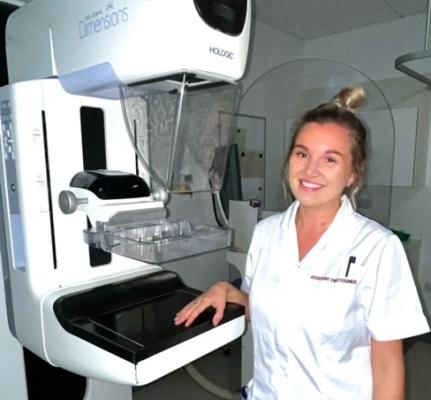Mammography associate
Mammography associates are members of the breast imaging team and play a vital role in finding signs of breast cancer early.
As a mammography associate, you’ll conduct high-quality routine mammography imaging to identify signs of cancer. This may result in people being referred for further diagnosis and treatment.
Life as a mammography associate
You’ll work in a team with mammographers, radiologists and other staff in a hospital or in a community setting eg mobile breast screening units and medical centres.
You’ll communicate and position people during the examination. You'll also prepare equipment and your work environment for screening (X-rays) to look for cancers that are too small to see or feel. Your work means earlier diagnosis of breast cancers meaning better outcomes for people being screened.
You’ll operate specialised mammography equipment used to screen people for breast cancer and be responsible for its monitoring and performance. You’ll also be responsible for producing high-quality images to support breast image services. You’ll work under the supervision of a registered radiographer working in mammography so you'll be fully supported at all times.
Alexandra Rogers
Assistant practitioner in mammography
Read Alexandra's storyI am very proud of my passing my qualification. I can now work in a role that makes such a difference to people.

How much can I earn?
If you’re employed by the NHS, you’ll be on a national pay and conditions system called Agenda for Change (AfC).
As a mammography associate you’ll usually be paid at band 3 while training and band 4 once qualified. Terms and conditions can vary if you are employed outside the NHS.
How about the benefits
As a mammography associate, you’ll
- make a real difference to patients’ lives, while pursuing a worthwhile, challenging and varied career
- work flexibly with opportunities for part-time hours
- have access to an excellent pension scheme
- enjoy NHS discounts in shops, restaurants and online
Must-have skills
- excellent interpersonal skills
- adaptable and flexible
- honest, open and trustworthy
- problem solving
- being able to effectively delegate and supervise
Entry requirements
You’ll need qualifications such as GCSEs in English and maths at 9-4 or A-C or equivalent level 2 qualifications such as functional skills to apply for a mammography apprenticeship.
How to become a mammography associate
You’ll undertake a level 4 qualification, such as an apprenticeship, to become a mammography associate. The apprenticeship is typically a twelve-month training programme (can be longer if working part-time) where you’ll combine academic learning with on-the-job clinical training. Your first step is to successfully apply for a job in the NHS. Your employer will then ensure access to appropriate training via their preferred Apprenticeship provider.You can apply for the apprenticeship via the NHS Jobs website or you can find live vacancies in your area below.
Where a career as a mammography associate can take you
There are a range of career opportunities for mammography associates. You may decide to train as a diagnostic radiographer or therapeutic radiographer either through a degree apprenticeship or undergraduate or postgraduate degree.
-
Clinical Scientist - Radiation Physics (DR and Mammography)
Maidstone, ME16 9QQ
- Salary :
- £47810.00 to £54710.00
- Type :
- Permanent
- Employer :
- Maidstone and Tunbridge Wells NHS Trust
-
Breast Surgery SHO
Sutton, SM2 5PT
- Salary :
- £52656.00
- Type :
- Fixed-Term
- Employer :
- The Royal Marsden NHS Foundation Trust
-
Breast Cancer Pathway Coordinator
Harrogate, HG2 7SX
- Salary :
- £27485.00 to £30162.00
- Type :
- Fixed-Term
- Employer :
- Harrogate and District NHS Foundation Trust
-
Clinical Office Coordinator, Breast Surgery
Ashford, TW15 3AA
- Salary :
- £28860.00 to £31671.00
- Type :
- Permanent
- Employer :
- Ashford & St. Peter's Hospitals NHS Foundation Trust
Showing 4 of 4 results




